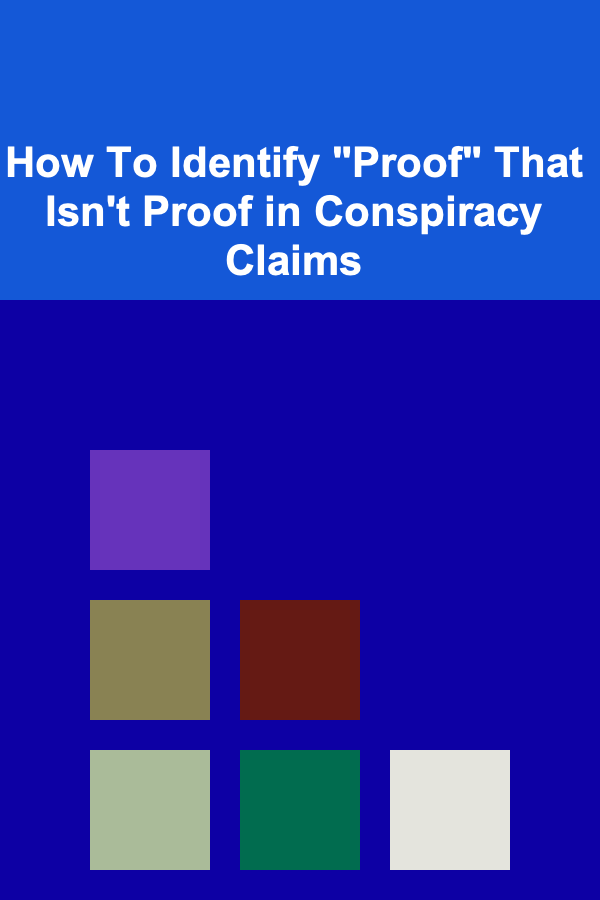
How To Identify "Proof" That Isn't Proof in Conspiracy Claims
ebook include PDF & Audio bundle (Micro Guide)
$12.99$5.99
Limited Time Offer! Order within the next:

In today's world, we are exposed to a vast array of information on a daily basis, much of it presented in the form of claims, arguments, and so-called "proofs." Conspiracy theories, in particular, often make strong assertions, accompanied by what seem to be undeniable pieces of evidence or "proof." However, not all evidence is created equal. Some arguments masquerade as facts but lack the necessary rigour, context, or credibility to be considered true proof. In this article, we will explore how to identify "proof" that isn't proof in conspiracy claims, equipping you with the critical thinking tools necessary to navigate the world of misinformation.
Understanding the Nature of Proof
Before diving into the specifics of how to spot false "proof," it's essential to understand what constitutes legitimate proof in an argument or claim. Proof, in any context, refers to a body of evidence or logical reasoning that firmly establishes the truth of a proposition. In scientific, historical, or legal contexts, proof is typically based on verifiable facts, reproducible results, and consistent reasoning.
In conspiracy theories, however, "proof" is often more subjective, and is used in ways that can mislead or manipulate an audience. Conspiracies often rely on cherry-picked data, half-truths, or logical fallacies to present a narrative that appears convincing but doesn't withstand scrutiny. To recognize when something is not truly proof, we need to first understand the characteristics of poor or flawed evidence.
Common Types of False "Proof" in Conspiracy Claims
1. Cherry-Picking Evidence
Cherry-picking refers to selecting only the pieces of evidence that support a specific claim while ignoring or dismissing evidence that contradicts it. This selective use of information is a common tactic in conspiracy claims because it allows the conspiracist to present a distorted version of reality that supports their narrative.
For example, a conspiracy theory about a particular historical event may focus solely on a few out-of-context quotes or documents that seem to suggest foul play, while disregarding a wealth of evidence that contradicts these claims. The result is a skewed argument that seems convincing but is far from comprehensive or objective.
How to Spot Cherry-Picking:
- Look for evidence that is presented in isolation. What is left out of the argument?
- Verify whether opposing evidence is being ignored or dismissed without consideration.
- Check if the evidence is cited from multiple reputable sources or just one biased source.
2. Appeal to Authority
An appeal to authority occurs when a claim is presented as true simply because an authoritative figure or expert says it is, without providing substantial evidence to back it up. In the case of conspiracy theories, appeals to authority are often used when the authority figure has some superficial relevance to the topic but lacks genuine expertise in the area.
For example, a conspiracy theorist may cite a person with a background in a related field (e.g., a physicist or a doctor) as evidence for their claim about a completely unrelated subject (e.g., political events or historical occurrences). This is problematic because an expert's opinion doesn't automatically validate a claim without proper supporting evidence.
How to Spot Appeals to Authority:
- Examine the credentials of the individual being cited. Do they have expertise in the relevant field?
- Look for independent verification of the claims, not just reliance on one individual's opinion.
- Question whether the claim is based on verifiable evidence or merely the authority of the individual.
3. Misleading Statistics
Conspiracy theorists often manipulate statistics to make their claims appear more credible. Statistics can be powerful tools in supporting an argument, but they can also be easily distorted by using selective data, misrepresenting findings, or using confusing comparisons.
For example, a conspiracy claim might cite a small group of people who share a certain belief or experience and then generalize this to a much larger group. Alternatively, they may use a misleading percentage without explaining the actual numbers behind it, making a small issue seem much larger than it really is.
How to Spot Misleading Statistics:
- Look for the actual numbers behind the statistics, not just percentages.
- Check the sample size---was the sample large enough to make valid generalizations?
- Consider the context in which the statistics are used. Are they relevant and presented honestly?
4. Circular Reasoning
Circular reasoning, also known as "begging the question," occurs when the conclusion of an argument is assumed in one of the premises. In conspiracy theories, this often manifests in claims that "the government is hiding the truth because they always hide the truth" or "the media is lying because they always lie." This creates an argument that lacks independent support and essentially uses the conclusion as evidence for itself.
How to Spot Circular Reasoning:
- Identify the core argument and assess whether the evidence presented is truly independent or simply restates the conclusion.
- Look for situations where the premise and conclusion are interchangeable or redundant.
- Question whether the reasoning has external support beyond the claim itself.
5. False Causality (Post Hoc Ergo Propter Hoc)
False causality occurs when a cause-and-effect relationship is assumed based on a mere correlation between two events, without demonstrating a clear causal link. In conspiracy claims, this can lead to the belief that two events that happened together must be related in a meaningful way, even though they may not be.
For instance, a conspiracy theory might argue that the stock market crash in 2008 was caused by a covert political operation, simply because both events occurred around the same time. However, proving a direct link requires far more detailed analysis than just noting that two events happened concurrently.
How to Spot False Causality:
- Look for concrete evidence of a direct cause-and-effect relationship, not just a correlation.
- Question whether alternative explanations for the events have been considered.
- Examine whether the theory relies on mere timing or if a genuine causal mechanism is being provided.
6. Appeal to Emotion
Conspiracy theories often rely heavily on emotional appeal, aiming to provoke fear, anger, or suspicion in order to persuade people to accept their claims. Instead of presenting solid evidence, conspiracists may use dramatic language, images, or anecdotes to evoke strong emotional reactions, making it more difficult for people to think critically about the argument.
For example, a theory might describe a supposed cover-up in such a way that it elicits outrage or fear, but when you strip away the emotional language, the actual facts or evidence are weak or non-existent.
How to Spot Appeals to Emotion:
- Evaluate whether the claim is focusing on logical reasoning or relying on emotional language.
- Recognize when an argument attempts to provoke fear, anger, or confusion without presenting clear evidence.
- Stay grounded in the facts, and try to distance yourself from emotional manipulation.
7. Ad Hominem Attacks
An ad hominem attack occurs when the character, motive, or other irrelevant aspects of a person's identity are attacked instead of addressing the substance of their argument. In conspiracy claims, those who challenge the theory may be discredited as "part of the cover-up" or "paid agents," rather than having their arguments examined and refuted.
This tactic shifts the focus away from the evidence and onto personal attacks, making it harder to engage with the actual claims being made.
How to Spot Ad Hominem Attacks:
- Check if the argument focuses on attacking individuals rather than addressing the claims they are making.
- Be aware of efforts to discredit experts or critics instead of discussing the validity of their analysis.
- Look for genuine counterarguments based on evidence rather than personal attacks.
Strategies for Identifying Weak "Proof" in Conspiracy Theories
1. Verify Sources
The first and most important step in evaluating any claim is to check the sources. Credible evidence should come from reliable, well-regarded sources. If a claim is sourced from a single, unknown, or biased individual or organization, it's worth questioning its validity. Cross-checking facts with independent sources is a key method for verifying the truth.
2. Look for Contradictory Evidence
Conspiracy theories often present a one-sided view of the world, selectively choosing evidence that supports their narrative. By actively looking for contradictory evidence and considering alternative explanations, you can uncover the holes in the argument and identify when the proof is faulty.
3. Assess the Logic of the Argument
Critical thinking involves analyzing the logic behind an argument. Is the reasoning consistent and sound? Does the evidence actually support the conclusion? Avoid falling into logical fallacies like false dilemmas, strawman arguments, or appeals to authority.
4. Seek Expert Opinions
When in doubt, seek out experts in the relevant field. Experts can provide context and help clarify whether the "proof" presented in a conspiracy theory is legitimate or if it is based on misinformation or misinterpretation.
5. Question the Motive
Lastly, consider the potential motives behind the conspiracy claim. Who benefits from the spread of this theory? What agenda is being pushed? Understanding the motivations behind a claim can help you assess its credibility and identify whether the so-called "proof" is being used to manipulate or deceive.
Conclusion
While conspiracy theories can be compelling, they are rarely built on legitimate evidence. By recognizing common tactics like cherry-picking evidence, appeals to authority, and circular reasoning, we can better evaluate the validity of the so-called "proof" presented. Critical thinking, source verification, and an openness to alternative explanations are essential tools in identifying weak or false evidence. By staying vigilant and applying these strategies, we can protect ourselves from being misled and ensure that we make decisions based on reliable, verifiable facts.

How to Make a Checklist for Managing Website User Accounts and Permissions
Read More
How to Reflect on Past Events for Better Planning
Read More
What Are the Top Tips for Organizing Your Garage?
Read More
How to Draw Architectural Interiors
Read More
How to Live Your Best Life
Read More
How to Design a Semester-Specific Academic Planner
Read MoreOther Products

How to Make a Checklist for Managing Website User Accounts and Permissions
Read More
How to Reflect on Past Events for Better Planning
Read More
What Are the Top Tips for Organizing Your Garage?
Read More
How to Draw Architectural Interiors
Read More
How to Live Your Best Life
Read More